Brzeg 2008-12-29
Former Soviet airport in Brzeg.
Geographic coordinates: 50.838N 17.409E. Elevation 151 m.
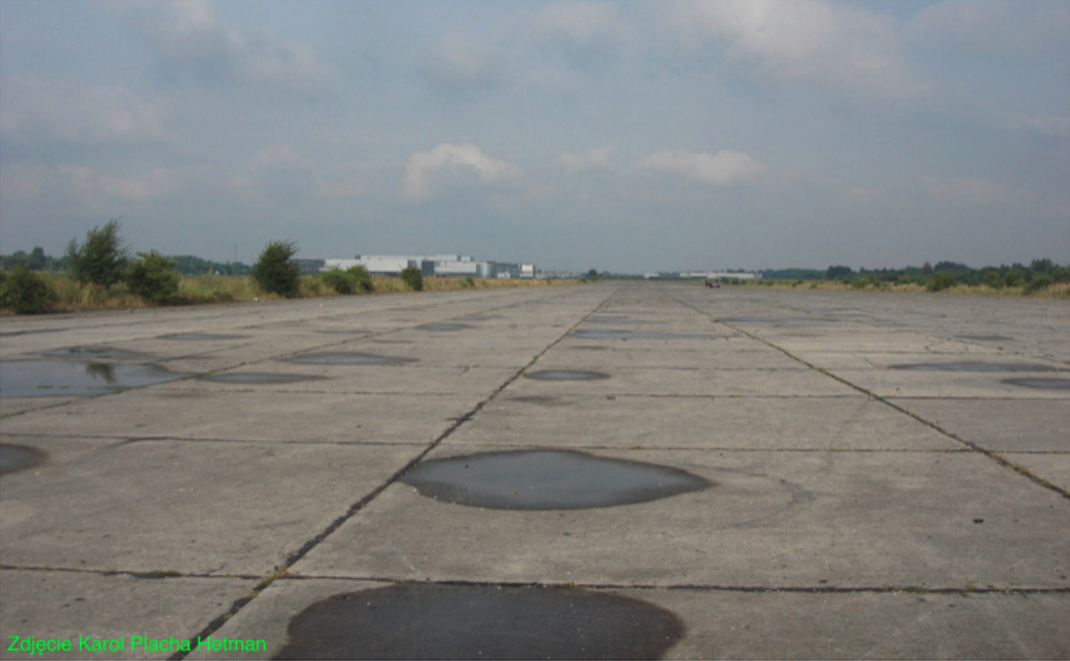
Photo description: Runway of the former Soviet airport in Brzeg. Cadbury's chocolate factory in the distance.

Photo description: 1 Fuel depot - MPS No. 1. 2 Skarbimierz housing estate. 3 Fuel depot - MPS No. 2. 4 CPPS and main taxiway. 5 DS (RWY). 6 Biedronka center. 7 Shelter-hangar of the Opole Aero Club. 8 The area of the German POW and concentration camp. 9 Southern aircraft and PPS centering zone. 10 Keiper company. 11 Cadbury Company. 12 Western aircraft and PPS centering zone.
Development of infrastructure at the Brzeg airport.
The Soviets in Brzeg occupied a large area. This did not stop them from further expanding the base area. In the 1950s, the base reached a maximum area of approximately 680 hectares. The airport was approximately 5,000 m long and over 2,000 m wide. With the introduction of increasingly faster aircraft into service, the DS (RWY) in the 09/27 direction was modernized. The modernization consisted not only in extending the RWY, but also in widening it. Initially (around 1955) it expanded to a length of 1,900 m and a width of 40 m, to reach 2,500 m x 60 m by the end of the 1960s. An area of 150,000 m2. The concrete surface was capable of receiving An-12 and An-22 transport aircraft.
Taxiways. Initially, the taxiways were dirt, but relatively quickly the second and third taxiways began to be used as runways. Over time, concrete roads leading from the hangars to RWY were built. The main taxiway is located parallel to the main runway, on the northern side, 300 m away. In total, over 8,000 m of taxiways were built, with an average width of 20 m.
Stands. Already in the 50s, individual concrete parking spaces for aircraft were created. First, they were located along the second and third runways. At the same time, self-seeding trees were allowed to grow and cover the stands. This area (the southern part of the airport) became the first re-centering area. Due to the large number of aircraft stationed in Brzeg, the second centering area was located in the north-western part of the airport. In the 1960s, due to the experiences of the Vietnam War, the stands were surrounded on three sides by earth embankments up to 4 m high, and only a few years later the first shelter hangars began to be built. A total of 54 individual aircraft parking spaces were created, 40 in the southern center area and 14 in the north-western center area. In addition, we will write that in the road structure we can see several individual parking places for German-style planes, the construction of which began during World War II.
Shelter hangars. Ultimately, 30 shelters and hangars, known in Soviet terms as ubnia (lubnia), were built at the airport. Shelter-hangars were made in two versions. Soviet shelter-hangars had the markings AU - angar ubnia. The AU-11 version accommodates a MiG-21 aircraft, the AU-16 version accommodates a Su-27 aircraft. Typical dimensions of the first hangars used in the Warsaw Pact were 12 m x 24 m x 6 m. (The order of dimensions is given in the same way as aircraft dimensions, i.e. span x length x height). These dimensions allowed aircraft operated in Brzeg to be accommodated in the hangar; Yak-25, Yak-27, Yak-28. The problem arose when two more types were introduced into service; MiG-25 and Su-24. The former did not fit in width and the latter in height. It was necessary to build larger shelters and hangars.
PPS (Plane Standing Areas). The airport had three PPS. One PPS was located in the southern part of the airport. On the southern side it had an embankment, on one side with a concrete surface. The plane had dimensions of 400 m x 50 m. Its area was 20,000 square meters. Currently (2010) it is already demolished. The second PPS probably served as a CPPS (Central Aircraft Parking Area) due to the shortest distance from the command headquarters. It was located on the main taxiway. Its size and design were identical to the first PPS. Currently (2010) it has also been demolished. The third PPS was the smallest. It has dimensions of approximately 40 m x 100 m and an area of 4,000 m2. Presumably, during World War II, it was a plane in front of a now non-existent hangar.
Air traffic control towers. One air traffic control tower is located near the main taxiway to the west of CPPS. Currently (2010) the building is still standing. Around 1985, the Soviets began to erect a new air traffic control tower, which they located between CPPS and RWY (about 30 m from CPPS). This facility was not completed. After 1993, it was not known what to do with the facility. For a short time it became the seat of the District Road Administration. Today (2010) there is no trace of the building. Keiper's parking lot is located here.
Airplane hangars. In history, Brzeg airport had several hangars. The first hangar was probably built around 1935. In total, by the end of the 1980s, there could have been as many as 8 hangars at the airport, of various sizes and purposes. Four of them were located not in one line, but in an arc, and the remaining ones were located a little further away. All this was aimed at reducing the effectiveness of a possible air attack. Currently (2010) there are only 5 hangars left and none of them serves as an aviation facility. They were mostly occupied by industrial companies. For example, the Okpol company (a window manufacturer) or the religious association of Jehovah's Witnesses.
MPS. The Soviets left two bases of propellants and samariums at the facility. One located in the south, the other smaller one in the east. The total capacity of underground and above-ground tanks was 23,000 cubic meters. Both MPS units have not stopped fulfilling their fuel function even for a moment, and they continue to do so now (2010). They mainly function as a customs warehouse. But until now, the companies that exploited and exploit them have raised eyebrows. It is not possible to provide information about the ownership of the existing assets, but we will only write that these facilities were involved in the "fuel scandal". 1,263 companies were involved in the case. Charges were brought against 330 people and 50 people were arrested. The case had its roots in ownership transformations after 1989 and lasted for several years.
The rest of the facilities were also impressive. There was an entire repair base capable of carrying out the most complex repairs. The repair base was used not only by regiments based in Brzeg, but also by other airfields in Poland, the GDR and Czechoslovakia.
The base also had two bomb depots, an aircraft shooting range, a car base, a command bunker, a shelter system, guardhouses, and posts. This should include the buildings of the barracks, headquarters, canteen, NKVD-KGB prison, officers' housing estate (10 blocks), canteen, shops, school, swimming pool, and sports facilities. The base was supplied with three means of communication. By road (road), through railway sidings and, of course, by air.
Life under pressure.
Today it is difficult to imagine what life was like for the inhabitants of Piastowski Brzeg with the Soviet garrison and the airport, the runway of which was only 4 km away from the city center. From which airport planes took off day and night, causing noise and cracking window panes.
From 1945, the Soviets occupied the airport and the city of Brzeg. They treated these and other objects in Poland as a kind of war spoils. And they had no intention of leaving it. The seizure of the airport and associated facilities could be explained and, above all, should be based on an appropriate international agreement. But the wandering of armed soldiers for almost 50 years on the streets of the city (located within the borders of Poland, which the great people of this world determined without our participation) was incredible. Let's call it what it is - Brzeg was occupied by Moscow until 1993. The unruly Soviet army repeatedly committed beatings, violence, rape, acts of vandalism and theft. They were much more aggressive than the communist apparatus of Poland. Especially under the influence of alcohol, which for many of them was the only entertainment. The Polish militia rarely dared to intervene. The inhabitants were powerless.
The first anti-Soviet demonstration broke out in October 1956. With shouts of "Down with the Russians, Down with Rokossowski", the inhabitants of Brzeg marched to the barracks. They demanded that Soviet patrols be removed from the streets. The demonstrators demanded that the secretary of the PZPR District Committee, Józef Baławajder, remove Soviet troops from Brzeg. Of course, nothing like that happened. However, the courage of the residents bore fruit. Soviet soldiers withdrew from Starobrzeska Street, and the apartments there were allocated to those in need. The participants of the demonstration were not repressed. It was undoubtedly a success, in the face of possible retaliation.
In the following years, the situation stabilized due to the appropriate rotation system of Soviet soldiers in Poland. The maximum period of stay in Poland for a soldier is 5 years. Only a few stayed in Poland longer. Despite the slogan - "Kurica no ptica, Poland no zagrana", Soviet soldiers treated their stay with us as a reward. They felt in Poland like in the West.
Because life abhors a vacuum, special arrangements were created between the Polish population and Soviet soldiers. Here they were united by a common interest. The economic crisis that prevailed in Poland in the 1980s and empty shelves in stores forced residents to go to Soviet stores in the garrison. They were better equipped. There was chocolate, other sweets, canned goods, toothpaste, soap and cheap caviar, which no one bought anyway. Muscovites also brought toys and watches. We, in turn, offered them eggs, fruit and vegetables, which they felt a distinct lack of. But this trade was hidden, outside the shops. Fuel and alcohol were famous commodities. But the Soviets also offered so-called economic items; taps, pipes, wires, light bulbs and even sinks and bathtubs. This practice intensified as the end of their stay in Poland approached. Then the offer included soldier equipment, and even weapons and ammunition.
Personally, I had business contacts with the Soviets. In the 1980s, in Wrocław, during modeling events, I bought airplane models from Soviet officers, which were missing in our stores at that time. These soldiers were dressed in civilian clothes. They spoke Polish fluently, but their accent was typically Eastern. When asked where they came from, the answer was "Brzeg". And they usually didn't want to say more. However, they willingly talked a lot about planes.
We know little about the exploits of Soviet pilots in Polish skies. But the proximity of the city (only 4 km to the center) provided residents with many questionable attractions. Eyewitnesses did not and do not want to speak, fearing for themselves and their loved ones. The most annoying thing was the noise. If anyone heard an F-16 Jastrząb flying low, let them know that the noise of the MiG-25 was four times greater. The glass often broke and fell out of the windows. Roof tiles were falling. Everything in the houses was shaking, so much so that the walls were cracking. In 1989, we saw several reports on this topic on Polish Television.
There were accidents near the city of Brzeg. In Małujewice, rocket fragments completely destroyed the roof of a barn and damaged the porch of the house. Another time, a bullet fired from a deck gun fell into the pen and seriously injured the woman. In Łukowice, a strong gust of air (the pilot turned on the afterburner) knocked down the chimney. In 1988, the missile "caught" itself from the guide. He fell in the yard of one of the Opole farmers. It exploded, destroying buildings. pilots. Both engines stopped working during the flight. They could not be restarted and the plane became uncontrollable. The pilots received an order to eject from the plane, the machine with about 10,000 kg of fuel would fall on the shore. The crew took the plane out to an undeveloped area and left the plane. One of the pilots was killed by the explosion of the crashing plane, the other one burned his parachute and died on the way to the hospital. Both pilots were buried at the cemetery in Brzeg.
"Soviets go home."
Socio-economic changes in Poland, initiated in 1989 with semi-free elections, meant that the topic of Soviet bases was no longer taboo. In 1989, there were several street demonstrations in which participants under the slogans "Soviets go home", "Tanks to the Volga", "Down with the Soviet occupation"; showed their reluctance to the presence of Muscovites in Poland. Aviation accidents and incidents involving Soviet planes then became a bargaining chip. Let us remember that in 1990, about 200 Soviet combat aircraft were stationed in Poland, and the airports were constantly expanded.
On September 15, 1989, a meeting of the Society of Friends of "Restraint and Work" was held in Brzeg, organized by Wiktor Krzewicki (later editor-in-chief of "Kurier Brzeski"). It gathered over 2,000 inhabitants of Brzeg and the surrounding area. The demonstrators demanded the withdrawal of Soviet troops, making the fees for their stay more realistic, a ban on transporters and trucks passing through the city, and a ban on night flights.
Only on February 20, 1990, the deputy chief of the General Staff of the Polish Army, Major General Franciszek Puchała, introduced a ban on conducting training flights from the Brzeg airport at night, between 10 p.m. and 6 a.m., on combat and combat training aircraft, and a ban on flights on MiG aircraft. -25 in Polish airspace during the day and at night in supersonic ranges.
On February 22, 1990, a march from the Market Square in Brzeg to the Soviet barracks was organized by "Fighting Solidarity" and the Independent Youth Movement as an expression of protest against the stay of foreign troops in Poland.
On September 6, 1990, the first meeting of 19 cities and communes where the Soviets were stationed took place in Legnica. The participants critically assessed the current relations between Soviet soldiers and the Polish population. Attention was drawn to violations of provisions regarding the flights of airplanes and helicopters. An association of municipalities based in Legnica was established, the purpose of which was to put pressure on determining the status of Muscovites staying in Poland and setting a date for their move out.
On September 7, 1990, the Minister of Foreign Affairs, Krzysztof Skubiszewski, received the CCCP/Russian ambassador in our country, Yuri Kashlev, and handed him a note from the Government of the Republic of Poland to the CCCP government, addressed to the CCCP Minister of Foreign Affairs, Eduard Shevardnadze. In the note, the Republic of Poland proposed starting talks on the withdrawal of Soviet troops from Poland. There was also a mention of possible compensation for damage resulting from the stay in our country. On September 14, 1990, a second note was handed out in similar circumstances. Compared to the first one, it contained more detailed proposals. On September 17, 1990, the Freedom Party, headed by Mariusz Sokołowski, who later became a Brzeg city councilor, protested again. Then it seemed that the Soviets would never leave Brzeg.
At that time, special commissions of provincial environmental protection departments were already inspecting Soviet bases for environmental protection. What the inspectors found there was terrifying. Fecal sewage flowed directly into rivers. The boiler rooms did not have any dust removal devices. The soil was saturated with petroleum products.
In December 1990, official talks began between Poland and the CCCP regarding the withdrawal of the army from Polish territory. Subsequent rounds of talks took place alternately in Warsaw and Moscow. There were fifteen of them in total. The Polish side proposed that the troops leave Poland by December 1991. The Muscovites insisted on mid-1994, justifying it by saying that the withdrawal of their troops from Poland was part of the process of withdrawing troops from the GDR (about 600,000). During the January round of talks in Moscow in 1991, General Viktor Dubynin made a surprising statement: "The invincible and proud Soviet army, which once defeated the Germans, will leave Poland when it deems it appropriate, on the roads and routes it deems appropriate, with unfurled banners, in a way that it determines itself, and if anyone interferes with it, it does not take responsibility for the safety of the population of Poland.
Ultimately, however, both sides, reaching a mutual compromise, agreed in a document signed in May 1992 that by November 15, 1992, the combat units of the Soviet army would leave Poland, and the rest of the units (auxiliary, liaison) would be evacuated by the end of 1993. The so-called "zero option" was adopted in financial and property settlements. The official date of the start of the withdrawal of troops from Poland is April 8, 1991 (there were still talks regarding the date of completion of the departure of these troops), when in a ceremonial setting (in pouring rain) an echelon with equipment and soldiers from the stationed station left the base in Borne - Sulinów. operational and tactical missile brigades there.
In Brzeg, the Soviets transferred real estate in stages and very slowly. The least important objects were transferred first. At the same time, they dismantled everything that could be transported to Moscow.
On March 16, 1993, the last 50 Soviet soldiers left Brzeg. A day later (March 17, 1993) at the City Hall, Col. Borys Potapov, the last commander of Soviet troops in Brzeg, and Stanisław Branowicki, plenipotentiary of the Voivode of Opole, signed a protocol on the transfer of 7 post-Soviet facilities and areas of over 16 ha.
What remains of the Muscovites? Broken fences. Houses with broken windows, newspapers instead of curtains. Dismantled door handles, radiators, taps, sinks, balustrades. Tiles torn from the sidewalks. The smell of rot and dirt carried far into the city. The soil is contaminated beyond all imagination with petroleum-derived fluids. Garbage, garbage and more garbage. This is what the area of the former Soviet barracks looked like.
Changes after 1993.
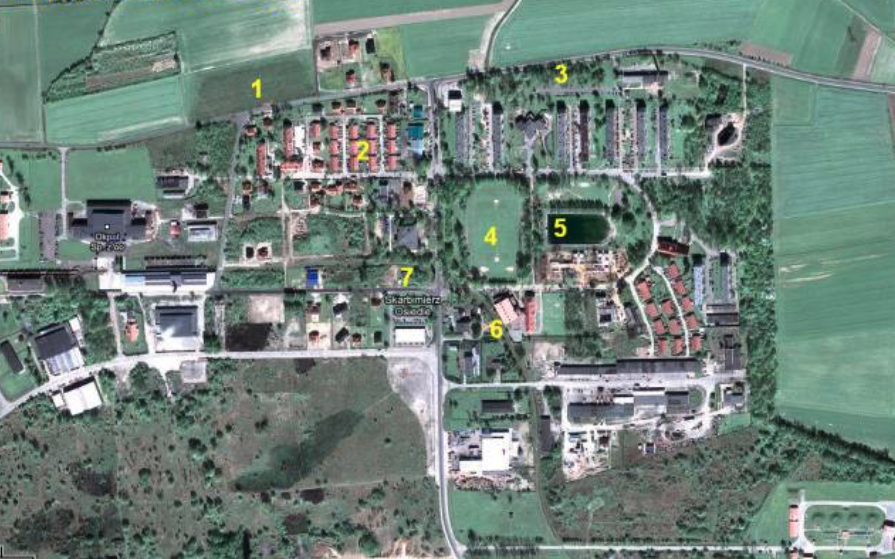
The rest of the base was devastated. The problem was unsettled ownership issues. But slowly the existing post-military facilities were used for civilian purposes. Service plants and small industries were established. The hangars housed; concrete plant, sawmill, sheet metal workshop, window factory. One hangar was occupied by Jehovah's Witnesses.
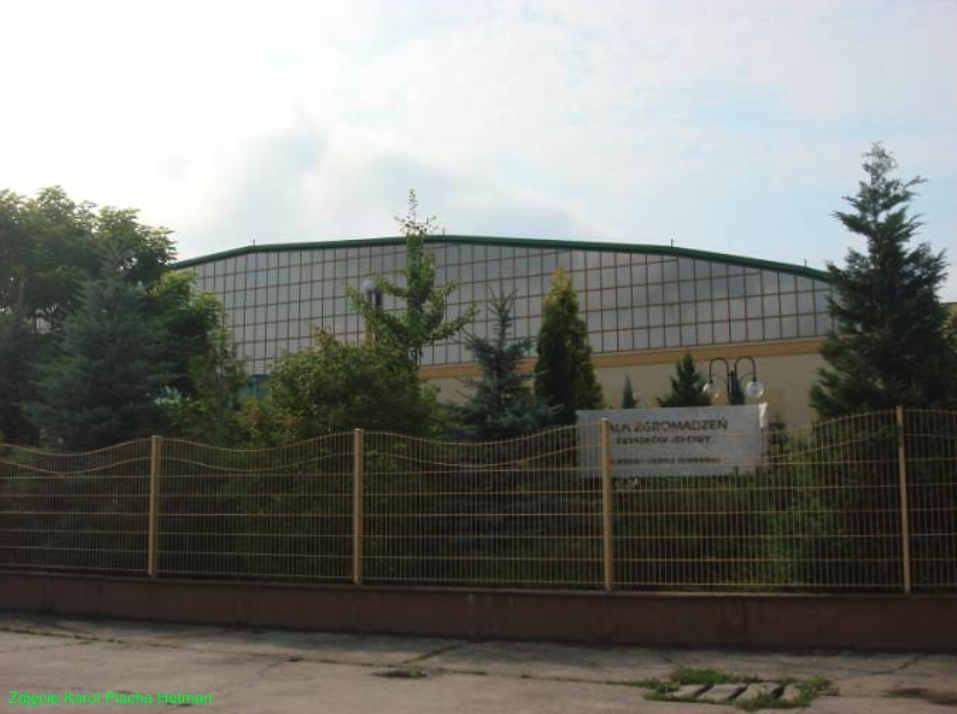
Most of the shelter-hangars were used for warehouses.
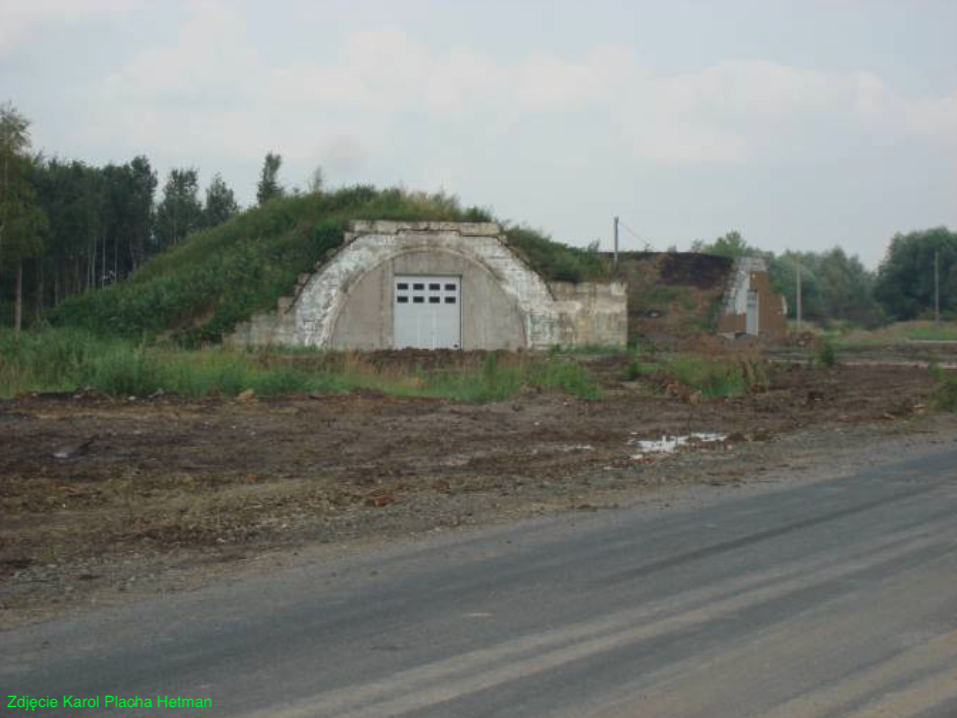
One of the facilities and the adjacent area was occupied by a company that recycled old Polish Army equipment, often incorrectly referred to as a scrapyard.
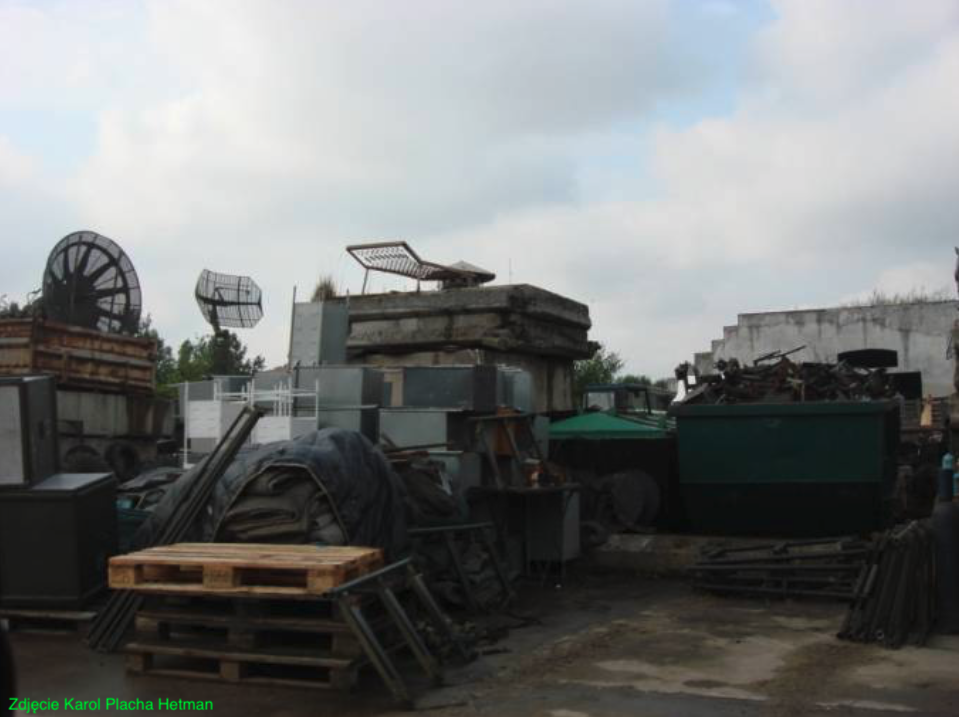
However, the attempt to establish a branch of the Opole Aero Club in Brzeg failed, and in the future it may create a new aeroclub. The Aero Club took over 2 or 3 shelter-hangars. An area of 140 hectares was planned for aviation activities. Unfortunately. The authorities decided not to maintain the facility as an airport.
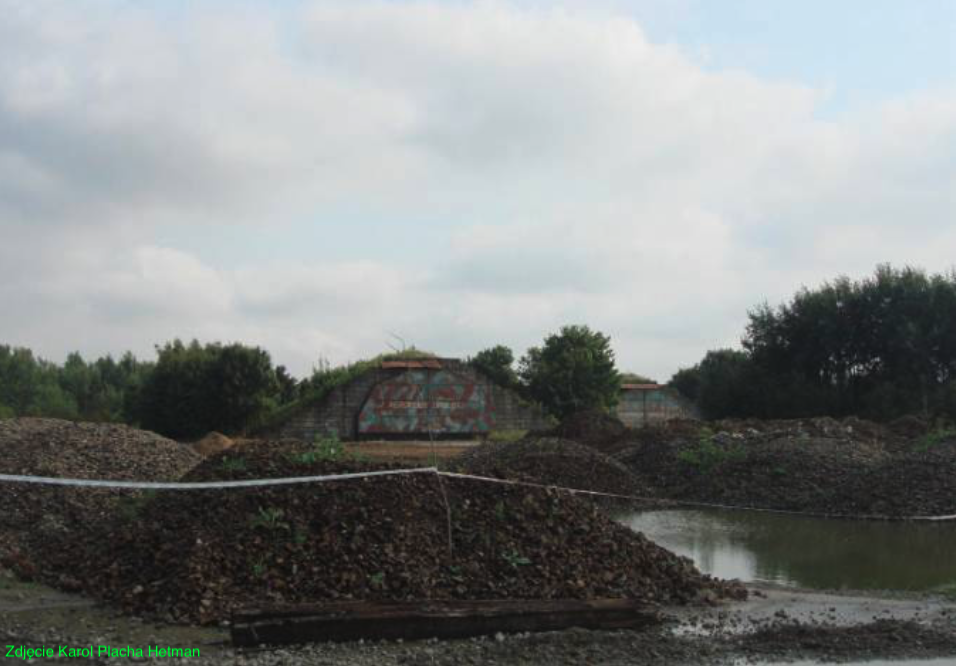
The District Road Administration in Brzeg operated for some time in the unfinished air traffic control tower. Some of the objects are still waiting for the owner. First of all, it is most difficult to find buyers for objects with typical military purposes. In the southern part, several shelters and hangars were demolished. Currently (2010), RWY is systematically dismantled and the concrete rubble is used for construction.
After numerous debates, after numerous debates, the huge area of the airport proper was designated as an industrial zone for industrial plants of companies with large capital. It had a total area of 460 hectares. In 2007, the area was parceled out. By 2009, 260 hectares had been sold. The authorities of Skarbimierz and Brzeg managed to attract (until 2010) three large companies; Keiper (manufacturer of car seats), Cadbury (producer of chocolate and chewing gum), Biedronka (retail chain). The Keiper factory opened in 2009 and employed 230 people. Cadbury was launched in 2010. Biedronka launched its logistics and warehouse center in 2011.
The city of Skarbimierz today. 2010.
Skarbimierz currently faces a great chance of becoming one of the most modern urbanized towns in Poland. The neglect of the 20th century can, paradoxically, be a good stimulus for development. There is no need to demolish or rebuild anything here. You have to create from scratch. And people in Skarbimierz are proactive and willing to act. List of streets for the city of Skarbimierz Osiedle; Acacia, Brzozowa, Cisowa, Dębowa, Jaśminowa, Chestnut, Maple, Larch, Automotive, Parkowa, Smaków, Topolowa, Willow.
The city of Brzeg today. 2010.
The city's area is 14.6 square kilometers. It is inhabited by 37,609 people (data from 2008). ZIP code 49-300. Telephone zone +48 77. Car license plates OB. Brzeg is a very nice Piast town where Polish, Czech and Prussian culture was concentrated. With an extremely rich history and a large number of monuments. Particularly worth seeing is the restored Piast Castle with the Piast Mausoleum and a constantly enlarged exhibition.
Written by Karol Placha Hetman
